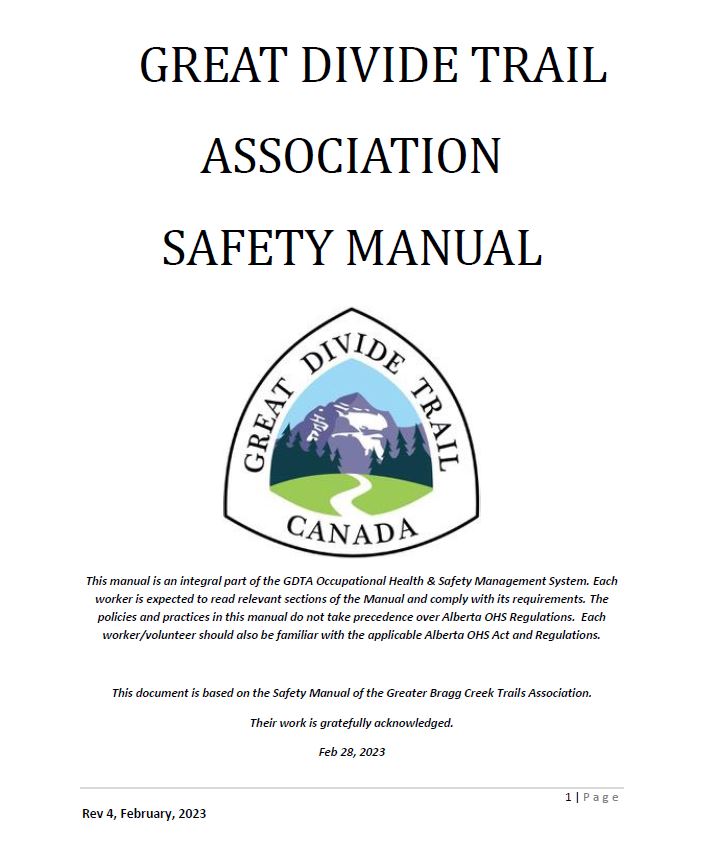GDTA Health and Safety Policy and Statement of Commitment
The Great Divide Trail Association is committed to developing and maintaining a strong health and safety program, providing a healthy and safe working environment for our volunteers and contractors, managing the trails system and GDTA property in an environmentally responsible way, and reducing risks to public users of the trails system. Our goal is to have our volunteers and contractors return home every day, healthy and without injury.
The GDTA works to:
- Clearly demonstrate our commitment to health and safety through responsible leadership and clear communications;
- Be compliant with legislation, regulations, and industry standards in relation to planning, operations, and equipment maintenance;
- Monitor the health and safety program and practices through continuous feedback from volunteers and review of best practices;
- Support volunteers and contractors in developing both awareness and understanding of health and safety issues related to GDTA work activities, encouraging a shared commitment to GDTA health and safety;
- Supports the coordination and cooperation of our workers concerning safety on the work site, encouraging safe work and feedback to improve our safety program;
- Provide volunteers with appropriate equipment, training, and a health and safety program to support a healthy and safe work environment; and
- Identify, evaluate, and manage the health and safety hazards and risks to which volunteers and contractors may be exposed.
All GDTA volunteers are responsible and accountable for our health and safety performance. Complete and active participation by everyone, every day, in every job is necessary for the safety excellence the organization expects.
Great Divide Trail Association Safety Manual
The GDTA Safety Manual is an integral part of the GDTA Occupational Health & Safety Management System, detailing our Health and Safety Policies, Safety Plans, and Safe Work Practices.
Safe Work Practices (SWPs):
SAFE WORK PRACTICE 1 – SAFE MANUAL LIFTING
SAFE WORK PRACTICE 2 – BOOSTING BATTERIES
SAFE WORK PRACTICE 3 – SAFE DRIVING
SAFE WORK PRACTICE 4 – CHANGING VEHICLE TIRES
SAFE WORK PRACTICE 5 – SECURING VEHICLE LOADS
SAFE WORK PRACTICE 6 – FUELING GASOLINE ENGINES
SAFE WORK PRACTICE 7 – SAFE LOADING OF SMALL EQUIPMENT
SAFE WORK PRACTICE 8 – VEHICLE EXTRACTION & WINCHING
SAFE WORK PRACTICE 9 – PORTABLE POWER & HAND TOOLS
SAFE WORK PRACTICE 10 – PREVENTING HEAT STRESS
SAFE WORK PRACTICE 11 – USING STEPSTOOLS & LADDERS
SAFE WORK PRACTICE 12 – USING A GAS BRUSH SAW
SAFE WORK PRACTICE 13 – ANIMAL ENCOUNTERS
SAFE WORK PRACTICE 14 – SEVERE WEATHER
SAFE WORK PRACTICE 15 – WORKING AROUND MOBILE EQUIPMENT
SAFE WORK PRACTICE 16 – WORKING ALONE IN THE TRAILS SYSTEM
SAFE WORK PRACTICE 17 – WORKING IN COLD ENVIRONMENTS
SAFE WORK PRACTICE 18 – USING A CHAINSAW
SAFE WORK PRACTICE 19 – USING CLEANING SOLVENTS & OTHER FLAMMABLES
SAFE WORK PRACTICE 20 – ATV/UTV USE
SAFE WORK PRACTICE 21 – SAFE TRAILER TOWING
SAFE WORK PRACTICE 22 – STARS PROTOCOL
SAFE WORK PRACTICE 23 – WORKING NEAR OR FORDING SWIFT WATER

